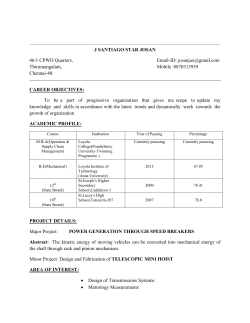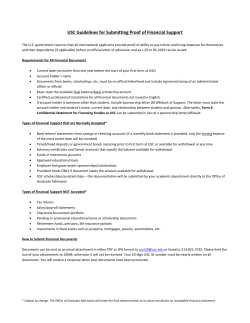
Newsletter - MOSSclone
April, 2015 Newsletter Issue 6 Welcome to the sixth newsletter of the MOSSCLONE project which is financed by the EU Commission’s Seventh Framework Programme. The aim of this project was to develop and implement a method to control the air quality by using a devitalized moss clone as passive contaminant sensor. The project encompassed the hard work of more than 30 experts from 11 organisations representing 5 EU countries (Spain, Italy, France, Ireland and Germany). This newsletter summarizes the development of the last 6 months of MOSSCLONE project. This newsletter is the last of a series of 6 newsletters that were published twice a year and were edited by the Project Manager (carlosbrais.carballeira@usc.es). We can say that Europe has funded the development of an important and essential tool for measuring any kind of air pollution and anywhere. Currently, we just need to extend the environmental awareness and knowledge of this new application. Thus, the certified mossphere will be used to measure air pollution in places that was previuosly impossible or unthinkable. What is MOSSCLONE? MOSSCLONE has meant the solution to avoid the problems associated with the traditional moss-bag technique to measure air pollution. These problems were: • The absence of well-suited moss species living in urban, extra-urban, and even indoor reference environments • The availability of natural and clean moss • The natural variability on moss elemental composition • The absence of a verified and standardized method Two key studies helped to overcome those problems: • Cultivation in the laboratory of a selected moss clone to always have clean and homogeneous material • High degree of standardization of the method. Edited by Carlos Carballeira 1 RECENT MOSSCLONE EVENTS Decision-making meeting (A Coruña , Spain) The Mossclone DoW included several meetings during project development. However, there was a period of one year without any meeting, between the midterm meeting (month 18) and the 3rd WP leaders meeting (month 30), so partners related with the last Mossclone tasks decided to met themseleves at A Coruña (Spain). This meeting was held the 13th of January (2015) at UDC facilities. The event was planned for the correct development of WP4 (Detectors) because partners encountered some sampling problems. USC, UDC, AMRA and BIOVIA attended the meeting. talked about the future of Mossclone results and the possibilities of collaboration on other projects. The second day was focused on showing to the general public how Mossclone has been developed, the results that were obtained in every activity and the advantages or disadvantages of the Mossclone method. This event was disseminated by the host university (UNINA) and Italian press and radio. The meeting attendants received a set of merchandising products of mossclone for the project dissemination; a mousepad (see picture below), a pen, a triptych, a notebook and a USB memory. All this products were carefully designed and were selected for the best dissemination procedure. Moreover, Final meeting at Naples (Italy) This work was carried out as part of WP5 (Dissemination and exploitation) of which the main objectives were: exchange of final results from finished activities, to discuss the ways to disseminate the mossclone method, to discuss patent applications and to help partners with the closure of the project. All WP leaders, one member of the advisory board and, at least, one representative of every partner attended the meeting. The Project Officer and several stakeholders were also invited to attend the meeting. This meeting took place on the 9 th, th 10 and 11th of March (2015) at the Aula Magna from the Congress Center Unina Federico II, located in Via Partenope of Naples (Italy). AMRA was the partner in charge of this meeting. The rector and several eminences of this university 2 (UNINA) welcomed all the attendants and explained their interest on the Mossclone project. The meeting was opened by Mrs. D. Simonetta Giordano, Professor of environmental and applied botanic, and Mr. D. José Ángel Fernández Escribano, as Scientific Coordinator, who welcomed the participants to the meeting. The Rector of the host institution/partner, Universita’ degli Studi di Napoli Federico II, also welcomed and thanked people attendance. Other eminences of the host university appreciated the people assistance and described their interest in the Mossclone project. During the first day, the final results of almost all activities of the project were presented and discussed, the patenting conditions were dealt and partners also 3 several Mossclone videos were projected as a summary of project activities. The evening of the second day Mossclone members enjoyed a pleasant and tasty social dinner at Ze Teresa restaurant which is located in front of the meeting point. The last day most of the partners went on an excursion to the Amalfitan coast; Positano, Amalfi, Ravello, Scala… The day was sunny and all partners enjoyed a beautiful and informative journey accompanied by a tour guide. The meeting ended as a friendly event where the finished activities were discussed and the expectations of all attendees were fulfilled. The schedule of the agenda was almost adjusted to perfection (see page 4). Meeting Agenda The final meeting lasted three days; one day of private meeting, one day of public and dissemination meeting and one day of fieldtrip. Monday 9th March 9:30-09:45 Welcome addresses and General presentation of the meeting (AMRA) 09:45-10:15 WP4: Tasks, Aims and procedures (ORION) 10:15-10:45 Results from Tasks 4.1 and 4.2 - Metals (AMRA) 10:45-11:00 TelLab activities Coffee break 11:30-12:00 Results from Tasks 4.1 and 4.2 - PAHs (UDC) 12:30-13:00 Results from Task 4.3 (UDC) 13:00-13:30 Results from Task 4.4 (USC) Lunch 15:00-15:15 Skype meeting with Aridane González (CNRS) 15:15-15:30 Monitoring Hg Experiments (Roberto Bargagli) 15:30-16:00 General discussion and final conclusions WP4 (All) 16:00-16:30 WP1 Project Management (USC) Coffee break 17:00-17:30 WP5 Exploitation and dissemination - Patenting (ALU-FR) 17:30-18:00 Future perspectives for the Mossclone Consortium and Conclusions (All) EUNETAIR Workshop at Riga EUNETAIR is a COST ACTION which means European network on new sensing technologies for air-pollution control and environmental sustainability. On the other hand, COST is the longestrunning European framework supporting trans-national cooperation among researchers, engineers and scholars across Europe. In this case, the main objective of EUNETAIR is to create a cooperative network to explore new sensing technologies for low-cost airpollution control through field studies and laboratory experiments to transfer the results into preventive real-time control practises and global sustainability for monitoring climate changes and outdoor/ indoor energy efficiency. EUNETAIR involves the coordinated work of 63 partners from different European countries. The 3rd EUNETAIR Workshop, based on New Trends and Challenges for Air Quality Control, was held the 26th and 27th of March (2015) in Riga, the capital and the largest city of Latvia. Workshop attendants enjoyed a two days event where partners and other stakeholders presented their studies and opinions through oral and poster presentations, discussions, social dinners and breaks... They also live contacted Hans Hartmann Pedersen, EC DG R&I Policy Officer. MOSSCLONE Coordinators were invited to attend this interesting EUNETAIR workshop. José Ángel Fernández (MOSSCLONE Scientific Coordinator, University of Santiago de Compostela) explained how the MOSSCLONE project has developed and obtained a tool for monitoring air quality using moss as passive sensor. For more information please visit www.eunetair.it. Tuesday 10th March 09:00-09:30 Welcome addresses (AMRA) 9:40-10:00 General presentation of Mossclone Project (USC) 10:00-10:20 What is MOSSCLONE? (USC video) 10:20-10:40 Moss clone cultivation (ALU-FR) 10:40-11:00 Moss clone characterization (AMRA, CNRS) Coffee break 11:30-11:50 Tool development: Standardization of the method (AMRA) 11:50-12:10 Tool development: Moss bag preparation and scaling up (BIOVIA) 12:10-12:30 Detectors: Comparison with traditional methods (ORION) Lunch 15:00-15:30 Welcome addresses (AMRA, UNINA Federico II, Stakeholders) 15:30-15:50 What is MOSSCLONE? (USC video) 15:50-16:10 Exploitation and dissemination (ALU-FR) 16:10-16:30 Advisory Board Notes 16:30-17:00 Future perspectives and Conclusions Wednesday 11th March One day excursion to the Amalfitan coast; Positano, Amalfi, Ravello and Scala. 4 5 Mossclone Workshop pictures Mossclone Workshop at Santiago de Compostela (Spain): The Mossphere Mossphere was publicly presented the last day of the project (31st of march, 2015) during a Workshop at Edificio Cersia, Santiago de Compostela (Spain). The place where the workshop was held belongs to Santiago de Compostela City Council who ceded the building for the Mossclone event. The workshop was broadcasted online and several media reported about the workshop: national and regional tv news, spanish national radio and regional press. Mossphere devices, posters and boxes were distributed around the room for the widest possible dissemination. Furthermore, Mossphere USB memories were given to the invited people. Different stakeholders and authorities presented and attended the presentation of mossphere: -Ethel Vázquez, Counselour for the Environment, Land and Infrastructure (Xunta de Galicia). -Reyes Leis, Councilor for Economic, with responsibilities in the areas of economic promotion, trade, markets, municipal slaughterhouse, employment and tourism (Santiago de Compostela city Council). -Isabel Rodríguez Moldes, Vice Chancellor for Research at University of Santiago de Compostela. -Sonia Pazos, Area Director of Axencia Galega da Innovación centers. -Prof. Dr. Miguel Ángel Ríos Fernández, Chairman of Real Academia Galegas das Ciencias (RAGDC). A couple of Mossclone partners and the Scientific Coordinator described development and the results of the project and they explained the advantages of using the mossphere instead of conventional methods. A snack was served after the presentations to enhance the collaboration and exchange of information between meeting attendants. The agenda of the workshop is shown below: MOSSCLONE Workshop at Santiago de Compostela Tuesday 31st of March (2015) 18:15 Authorities and Stakeholders Welcome 18:40 Dr. Angel Fernandez Escribano - Scientific Mossclone Coordinator and Professor at University of Santiago de Compostela (USC) 19:00 Dr. María Piñeiro Iglesias - Superior Technician in Analytical Instrumentation at IUMA (University of La Coruña, UDC). Mossclone Partner. 19:20 Mrs. Ana Isabel Rey Asensio - CEO at BIOVIA. Mossclone Partner. 19:45 Snack 6 7 WP4 Detectors Tasks from WP4 (Detectors) finished on the last month of the project, some of them took 3 months more than planned. Samples from cloned Sphagnum palustre were exposed together with traditional techniques; standard bulk deposition collectors, particle and gaseous samplers. Moss samples exposure was adapted to the conditions needed for the comparison with the results from traditional techniques. Moss samples were be covered, sheltered or used as passive diffusers. The development of WP4 tasks involved several problems so experiments were repeated in order to have a full set of data. The results obtained in this working package are very promising because they support the use of the Mossphere and the Mossclone method as useful air monitoring tools. For this reason, the application for patenting the moss clone, the method and the exposure device has been recently presented. FORTHCOMING EVENTS AND TASKS There are no more planned events and tasks because the project has recently finished (31st of March, 2015). However, further mossclone news will be published both on the website and social media (Facebook and Twitter Mossclone accounts). Project Achievements The MOSSCLONE project has definitively achieved all the objectives: √ √ √ √ √ √ √ Selection of moss species Creating a pilot bioreactor Characterization of the selected moss clone Scaling up moss clone cultivation Design and methodological standardization Moss-bags validation versus current state-of-the-art Initial validation for the detection of pollution focus MOSSCLONE Dissemination In the last 6 months the Mossclone project has been deeply disseminated: The MOSSCLONE project has been recently mentioned in the News of two Spanish regional TV channels (V and RTVG). TV Newspapers Radio More than 9 articles have been published in different Spanish and Italian newspapers; national, regional and online. The Final Meeting and the Mossclone Workshop were mentioned in several radio channels from Spain and Italy. During these events some partners were interviewed. Find out more on our website www.mossclone.eu Find Me on Facebook 8 facebook.com/MOSSCLONE Follow US on Twitter 9 @MOSSCLONE Thanks for your interest on our Project! We would also like to thank Advisory Board members (Dr. Javier Abaigar and Dr. Harald Zechmeister), authorities and governments who made possible the development of this project, especially the European Commision and the 7th Framework program (FP7). 01
© Copyright 2025












